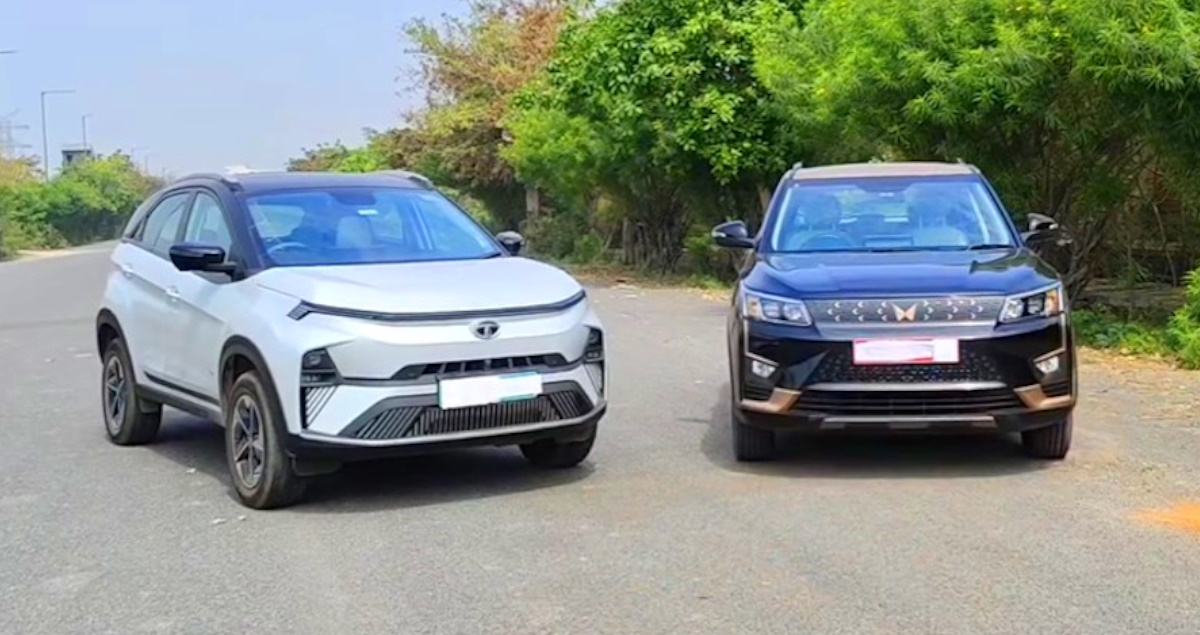The Indian EV market is slowly picking up pace. All the prominent brands in India, such as Hyundai, Maruti, Toyota, Tata and Mahindra, are launching their EVs in the hope of capturing this market in its early stage. There are two major players in India for compact EV SUVs: the Tata Nexon EV and Mahindra XUV 400. Today, with the help of a YouTube video, we will compare these two EVs.
The video is uploaded by Power on Torque on YouTube which gives us a detailed comparison of both the cars. Mahindra recently updated the XUV 400 on Jan 11, 2024, while the Nexon EV was updated in 2023.
Exterior
Both the cars have a distinct exterior design with their own set of features. The Nexon EV looks more similar to its ICE counterpart then XUV 400. The XUV 400 comes with a closed grille which gives it a complete EV look.
Talking about the design, the Nexon EV has more sharp lines and a modern design, while the XUV 400 has a bold SUV-like design with fewer sharp edges. Headlights in the Nexon EV are placed on the bumper, while the XUV 400 has a traditional headlight placement. The Nexon EV has a connected DRL at the front, which the XUV 400 misses out on.

The XUV400 has an LED setup with halogen fog lights, while the Nexon EV has an LED setup. Design is a subjective factor, and some may like Nexon EV over the XUV 400 and vice versa.
The Nexon EV is more loaded with features such as front parking sensors, a front camera and a 360-degree camera, which the XUV 400 does not offer. The side profile of both cars offers 16-inch alloy wheels with all four disc brakes. Both the cars come with dual-tone colour options, with Nexon having a floating roof design.
XUV 400 is bigger than the Nexon EV. It is 206mm longer 10 mm wider and 18 mm higher than the Nexon EV. This results in extra boot space and a spacious cabin in the XUV 400. In terms of wheelbase, the XUV 400 measure 2600mm while the Nexon EV measures 2498mm. The rear profile of both the cars is similar to their ICE counterpart with features such as all LED setup, wiper, washer and defogger.
Interior
The Nexon EV comes with a unique two-spoke steering wheel featuring an illuminated logo, steering-mounted controls and cruise control buttons. The EV is equipped with a floating touchscreen infotainment system.
The instrument cluster and HVAC controls are fully digital. Other amenities include wireless charging, three driving modes, ventilated front seats and a panoramic sunroof. The interior is finished in a beige and black theme. Nexon EV is also offered in a dark edition, which features a blacked-out theme inside and out.
Stepping inside the XUV 400, the steering wheel is a normal 4 spoke unt with media controls and cruise control. The interior theme is the same beige and black. The car comes with fully digital instrument cluster and a floating display with shortcut buttons for easy accessibility. It misses out of features such as ventilated seats and type-c port. Panoramic sunroof is offered in XUV 400.
Pricing
Pricing is an important factor when buying a new car. The Nexon EV is sub-4m and priced at Rs. 14.49 lakhs to Rs. 19.49 lakhs. On the other hand, XUV 400 is priced at Rs. 15.49 lakhs to Rs. 17.69 lakhs.
Power
The Nexon EV has a motor that produces 147 PS and 215 Nm of torque, while the XUV 400’s motor produces 150 PS and 350 Nm of torque.
Battery pack and Range
Both the cars offer two battery packs.
Nexon EV – A 30 kWh battery pack that has a driving range of 325 km, and a long-range variant with a 40.5 kWh battery pack and a range of 465 km. A 3.3 kWh charger can charge the Nexon EV in 14 to 15 hours, while a 7.2 kWh charger can charge in 8 to 9 hours. A DC fast charging option (50 kWh) is also available, and it can charge the Nexon EV from 0 to 80% in 60 to 65 minutes.
XUV 400 – It offers a bigger 34.5 kWh battery pack with a claimed range of 375 km and a 39.4 kWh battery pack which has a range of 456 km. Charging time from a 3.3 kWh charger is upwards of 13 hours. Using a 7.2 kW charger can reduce this time to around 7 hours, while a DC fast charge will charge the EV from 0 to 80% in around 50 minutes.
The normal range variant of Nexon EV has a smaller battery pack while it is the opposite in case of long range versions.
The post Tata Nexon.EV Compared With Mahindra XUV400 Electric SUV [Video] first appeared on Cartoq.
Source link

